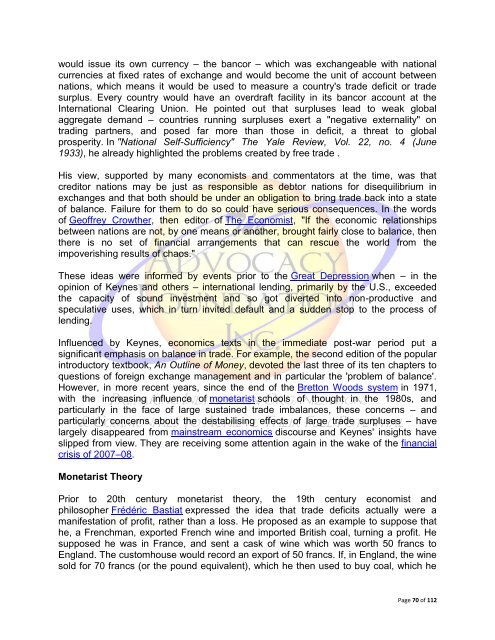De-Industrialization
De-Industrialization
De-Industrialization
You also want an ePaper? Increase the reach of your titles
YUMPU automatically turns print PDFs into web optimized ePapers that Google loves.
would issue its own currency – the bancor – which was exchangeable with national<br />
currencies at fixed rates of exchange and would become the unit of account between<br />
nations, which means it would be used to measure a country's trade deficit or trade<br />
surplus. Every country would have an overdraft facility in its bancor account at the<br />
International Clearing Union. He pointed out that surpluses lead to weak global<br />
aggregate demand – countries running surpluses exert a "negative externality" on<br />
trading partners, and posed far more than those in deficit, a threat to global<br />
prosperity. In "National Self-Sufficiency" The Yale Review, Vol. 22, no. 4 (June<br />
1933), he already highlighted the problems created by free trade .<br />
His view, supported by many economists and commentators at the time, was that<br />
creditor nations may be just as responsible as debtor nations for disequilibrium in<br />
exchanges and that both should be under an obligation to bring trade back into a state<br />
of balance. Failure for them to do so could have serious consequences. In the words<br />
of Geoffrey Crowther, then editor of The Economist, "If the economic relationships<br />
between nations are not, by one means or another, brought fairly close to balance, then<br />
there is no set of financial arrangements that can rescue the world from the<br />
impoverishing results of chaos."<br />
These ideas were informed by events prior to the Great <strong>De</strong>pression when – in the<br />
opinion of Keynes and others – international lending, primarily by the U.S., exceeded<br />
the capacity of sound investment and so got diverted into non-productive and<br />
speculative uses, which in turn invited default and a sudden stop to the process of<br />
lending.<br />
Influenced by Keynes, economics texts in the immediate post-war period put a<br />
significant emphasis on balance in trade. For example, the second edition of the popular<br />
introductory textbook, An Outline of Money, devoted the last three of its ten chapters to<br />
questions of foreign exchange management and in particular the 'problem of balance'.<br />
However, in more recent years, since the end of the Bretton Woods system in 1971,<br />
with the increasing influence of monetarist schools of thought in the 1980s, and<br />
particularly in the face of large sustained trade imbalances, these concerns – and<br />
particularly concerns about the destabilising effects of large trade surpluses – have<br />
largely disappeared from mainstream economics discourse and Keynes' insights have<br />
slipped from view. They are receiving some attention again in the wake of the financial<br />
crisis of 2007–08.<br />
Monetarist Theory<br />
Prior to 20th century monetarist theory, the 19th century economist and<br />
philosopher Frédéric Bastiat expressed the idea that trade deficits actually were a<br />
manifestation of profit, rather than a loss. He proposed as an example to suppose that<br />
he, a Frenchman, exported French wine and imported British coal, turning a profit. He<br />
supposed he was in France, and sent a cask of wine which was worth 50 francs to<br />
England. The customhouse would record an export of 50 francs. If, in England, the wine<br />
sold for 70 francs (or the pound equivalent), which he then used to buy coal, which he<br />
Page 70 of 112

















